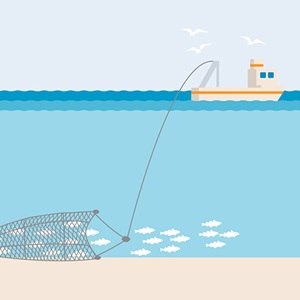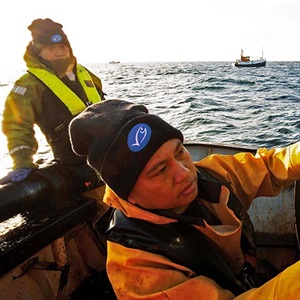Does bottom trawl fishing contribute to climate change? Find out more about the carbon footprint of fisheries that use this gear, and how fishing sustainably can reduce emissions.
What is the carbon footprint of bottom trawl fishing?
The main cause of carbon emissions from fishing is from the use of fossil fuels, and the carbon footprint is typically calculated by comparing the amount of fuel used for every kilo of seafood landed.
An analysis of over 870 studies into fuel use intensity found that, on average, bottom trawl fisheries use more fuel and produce higher carbon emissions than those using other other gear types, except for pots and traps. (Figure 1)
However, the carbon footprint of bottom trawling can vary considerably within and between fisheries. This is due to factors such as net mesh size, the depth, frequency, and duration of the trawl, and the age and size of fishing fleet.

How does the carbon footprint from bottom trawling compare with land-based farming?
Wild-capture fisheries in general provide a low carbon source of food and, unlike land-based farming, do not require resources such as land, feed, water or pesticides.
However, a comparison of the carbon footprints of different food items shows bottom trawl fisheries on average generate more carbon than all food groups investigated, with the exception of beef and farmed salmon (Figure 2).
The research also highlights the variation in carbon footprint between different bottom trawl fisheries. This includes the New Zealand hoki and ling bottom trawl fishery, which produces less carbon than pork and a similar amount to chicken, and the Alaska bottom trawl fishery, which produces less than half the carbon of pork. These fisheries are likely to have a lower carbon footprint due to good stock management and elimination of the 'race to fish'.

How can the carbon footprint of wild-capture fisheries be reduced?
Variation between fisheries means there is no one-size-fits-all method to reduce carbon emissions, however sustainable fisheries management can help reduce carbon footprint.
Research suggests that fuel use can be reduced when stocks are more abundant. This is because fishers don’t need to travel as far to find stocks and can catch their quota more quickly.
Fuel use can also be reduced by improving the efficiency of trawl gear and vessels. This includes using lightweight gear, and monitoring catch via cameras or sensors to reduce the time spent dragging the net.
Adopting management policies such as reduced vessel speed limits can also cut fuel use, alongside modernisation of fishing vessels and the use of more fuel-efficient or hybrid engines where feasible.
Does the MSC Fisheries Standard require fisheries to reduce their carbon emissions?
The MSC program focuses on the sustainability of fishing practices in relation to stock health, impacts on marine species, habitats and ecosystems, and effective fisheries management. There are currently no requirements in our Standard relating directly to carbon emissions from fishing vessels or seafood production.Can we replace bottom trawling with other methods of fishing to reduce carbon emissions?
Bottom trawl fishing accounts for approximately one quarter of all fish and seafood caught every year.
It would not be possible to catch the same volume of fish using different methods, and many species that live on or close to the seabed would not be caught without trawl gear.
Swapping bottom trawl gears for other fishing methods that use less fuel could help reduce carbon emissions, but the environmental impacts of other gears must be considered. For example, gillnets have a lower carbon footprint, but could increase bycatch of seabirds and marine mammals.
Some researchers also suggest that banning bottom trawling could increase the environmental impacts of food production. This is because the loss of fish would likely lead to increasing land-based farming and aquaculture, which have different environmental costs such as pesticide and antibiotic use and land clearance to provide crops and feed.
Does trawling the seabed release more carbon into the atmosphere than the aviation industry?
Several studies have attempted to quantify how much carbon is released back into the atmosphere due to fishing activities such as bottom trawling, but there is currently no scientific consensus.
Carbon within the ocean ecosystem can be 'fixed' in sediment when organic matter, like dead marine plants and animals, sink to the seabed. This sediment is disturbed by activities like bottom trawling and dredging, resulting in some of the carbon becoming redissolved in seawater.
In 2021, global media claimed that bottom trawling releases as much carbon into the atmosphere as the aviation industry. This was based on a study that primarily investigated the use of marine protected areas to restore biodiversity and reduce carbon emissions. It also included estimates of the amount of carbon released from seabed sediments disturbed by trawling.
However, the findings were widely criticised by other researchers, who claimed the amount of carbon released had been overestimated by up to 100 times. The critics believed this overestimation occurred due to several incorrect assumptions, such as assuming all carbon released from sediments will eventually reach the surface of the ocean and be released into the atmosphere.
A further paper was published in January 2024, claiming that up to 60% of the carbon disturbed by trawling could be released into the atmosphere within seven to nine years. However, this research used the same model to calculate carbon release as the 2021 study, so there remain concerns that the findings have been overstated.
To better understand the impact of trawling, further research is needed to clarify how much carbon is released back into the atmosphere and how much resettles on the ocean floor. Research will also need to consider variation between different seabed habitats.




